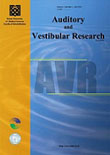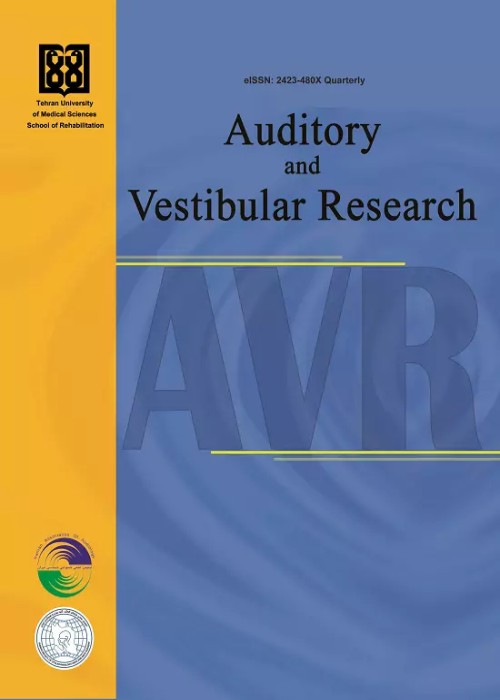فهرست مطالب

Auditory and Vestibular Research
Volume:24 Issue: 1, Winter 2015
- تاریخ انتشار: 1394/02/07
- تعداد عناوین: 8
-
-
Pages 3-10Background And AimCaffeine at low doses blocks adenosine receptors. These receptors are present in all parts of the body including auditory and vestibular system. This study aimed to evaluate the effects of caffeine on cervical vestibular evoked myogenic potential (cVEMP).MethodsIn this interventional double-blind study, 40 cases (20 females and 20 males) aged 18-25 years were randomly assigned into two groups: the test group, 3 mg/kg caffeine and little sugar and dry milk in 100ml water, and the control group, placebo including sugar and dry milk in 100ml water. Myogenic potential was recorded before and after intervention with 500 Hz tone burst in 95 dBnHL.ResultsThe statistical analysis revealed that there was no significant difference in p13 and n23 latency and amplitude asymmetry. However, the mean amplitudes of right ear (p=0.04) and two ears (p=0.02) of test group indicated a significant increase after caffeine ingestion. The results showed no significant difference in caffeine group compared to the placebo group in any of parameters and ears (p>0.05).ConclusionsWith current study small sample size we found no effect of 3 mg/kg dose of caffeine on cervical vestibular evoked myogenic potential. Although after intervention the significant increase in the amplitude of all samples was notable, no significant difference was found between the two groups. The present study was the first research in this area, however, larger sample size and different doses of caffeine is suggested for future studies.Keywords: Caffeine, adenosine, alutamate, cervical vestibular evoked myogenic potential
-
Pages 11-16Background And AimsThis is a pilot study investigated the prevalence of hearing impairment and the impact of the known risk factors for hearing loss on infants at risk born in Kuwait.MethodsTwo hundred infants with risk of hearing impairment who met the Joint Committee on Infants Hearing (1990) criteria were screened. All newborns were included in this study if they had hospital stay for more than 48 hours and at least with one of the known risk factors of hearing loss. At time of discharge from the hospital, they were referred for hearing screening at Ibn Sina Hospital, Clinical Neurophysiological Department. The hearing screening protocol included high frequency tympanometry, transient evoked otoacoustic emission (TEOAE) and auditory brainstem responses (ABR).ResultsOf 200 infants, 11.5% had sensorineural hearing loss (SNHL). There was no significant relationship between hearing loss and gender, but there was a significant statistical relationship (p≤0.05) between hearing loss and prematurity. Of 23 infants with SNHL, positive history of hearing loss occurred in five families, SNHL detected in four of the 19 cases with hyperbilirubinemia (17.4%), 2 of the 15 cases with severe perinatal asphyxia (p≤0.05), one of the 2 cases with a meconium aspiration syndrome (p ≤ 0.05), and a single case with gentamycin ototoxicity.ConclusionThe prevalence of hearing impairment in high-risk infants was 11.5%. About 43.48% severe prematurity (gestational age ≤ 30 weeks) was a main risk factor of hearing loss. This finding should guide healthcare providers when adapting their protocols.Keywords: Transient evoked otoacoustic emission, auditory brainstem responses, risk factors, hyperbilirubinemia, severe prematurity, sensorineural hearing loss
-
Pages 17-24Background And AimOmega 3 of essential fatty acids, especially in fish oil form plays an important role in structural, functional, and biological aspects in body. Omega 3 deficiency can have devastating effects on the nervous system and auditory. This study aimed to evaluate auditory threshold in n-3 fatty acid-deficient rat pups following supplementation of fish oil consumption during the suckling period.MethodsOne sources of omega 3 fatty acid were fed to rat pups of n-3 polyunsaturated fatty acids (PUFA)-deficient dams to compare auditory thresholds in 2, 4, 8, 12 and 16 kHz by auditory brainstem response (ABR) among this group, those with defects with placebo, and control groups. The pups'' in supplement group were orally fed 5 mol/g weight of fish oil between the ages of 5 and 21 days.ResultsResults showed significant differences in auditory threshold estimation in 2,4,8,12 and 16 kHz in ABR between study groups. The group with n-3 PUFA deficient with placebo showed a significant increase of the parameters indicated as p<0.05. Moreover a lower threshold (better) in n-3 PUFA deficient with the fish oil in comparison with n-3 PUFA deficient with placebo (p<0.05).ConclusionThe result of study showed effect of omega 3 deficiency on auditory during pregnancy and lactation period and compensation neural auditory threshold in n-3 fatty acid-deficient rat pups following a supplementation of fish oil consumption during the suckling period.Keywords: Fish oil, auditory thresholds, n3 fatty acid deficiency, rat pup, auditory brainstem response
-
Pages 25-30Background And AimCued Speech makes speech perception easier and improves both lip-reading ability and residual hearing usage. The purpose of the present study was to assess the effectiveness of using Cued Speech on story retelling as a rehabilitation tool for late cochlear implanted, prelingual, hearing-impaired students.MethodsThis was an experimental study with a pre- and post-test plan. Nine prelingually hearing impaired students were selected from Loghman Cochlear Implant Center. All were late cochlear implanted and were aged between 11 and 16 years and 9 months. The study tool involved a storytelling test. The Persian Cued Speech training program was conducted for eight weeks in sixteen 60 minute sessions. In this study we used a Z-test and t-test for analysis of dependent variable.ResultsAfter the Persian Cued Speech intervention all the narrative’s macrostructural (topic maintenance, event sequencing, main information, (p<0.01) and microstructural (referencing, p<0.05 and mean length of utterances, (p<0.01) items were significantly improved. There were no significant differences in two microstructural items (conjunction cohesion, syntax complexity).ConclusionThe study shows that using Cued Speech for the late cochlear implanted, prelingual, hearing impaired students can improve story retelling abilities and can be used in rehabilitation programs for these groups.Keywords: Cued Speech, story retelling, hearing impaired, cochlear implant, late implanted
-
Pages 31-37Background And AimSpeech understanding almost never occurs in silence. Verbal communication often occurs in environments where multiple speakers are talking. In such environments, babbling noise masks speech comprehension. Consonants, in comparison to vowels, are more sensitive to noise masking. Consonants provide most acoustic information needed for comprehending the meaning of the word. Since stop consonants have low intensity, they can be easily masked by noise, and finally tend to lead to speech disorder. This study determines the effect of babble noise on the recognition score of stop consonants.MethodsThis cross-sectional study was performed on 48 participants, males and females in equal number, aged between 19 and 24 years, with normal hearing. In addition to auditory and speech evaluation, recognition of stop consonants in a consonant–vowel–consonant syllable at the presence of babbling noise was tested.ResultsBy increasing the noise, the recognition score of stop consonants at the beginning of the syllable was reduced. There was a meaningful difference between the recognition score of stop consonants at the beginning of the word and vowels in the signal-to-noise ratio of 0, -5, and -10 (p=0.000). Besides, the average recognition score of /b/, /d/, /k/, and /ʔ/ was found to be greater than /p/, /t/,/g/, and /q/ (p<0.0005). Gender had no significant effects.ConclusionsIncreased babble noise levels significantly reduce the recognition score of stop consonants, and this reduction is more in some voiced stop consonants as well as some voiceless stop consonants.Keywords: Stop consonants, speech in noise, babble noise
-
Pages 38-41Background And AimAuditory temporal resolution skill is calculated according to the minimum required time to analyze or integrate acoustic events. This skill, which is essential for speech perception, was evaluated by gap detection tests. The aim of this study was to determine the presence or absence of any differences between the right and left ear in the gap detection test.MethodAfter performing auditory tests to rule out any hearing loss or auditory processing disorders, the gap detection test was administered to 40 adults.ResultsGap detection thresholds were 5.35 ms and 5.30 ms in the right and left ear, respectively, and the average correct answers percentages were 69.03% and 68.03% in the right and left ear, respectively. According to these data, results were similar for both ears.ConclusionThere is no laterality in temporal resolution tasks. However, we cannot generalize the results of the present study as being applicable to the whole society.Keywords: Auditory cortex, gap in noise, temporal resolution, central auditory processing, laterality
-
Pages 42-50Background And AimAs the most perceived and articulated errors of hearing aid users occur in high frequency speech phonemes, this study aimed to find a way to amplify and reconstruct the errors. Thus, the study first prepared a recorded form of two Persian fricative consonants as stimulus; then, the rate of the prescribed gain of the two methods of National Acoustic Laboratories-Nonlinear 2 (NAL-NL2) and the Desired Sensation Level Multistage Input/Output (DSLm[i/o]) were compared.MethodsThis study was performed using eight programmed hearing aids for severe sensorineural hearing loss in three configurations: flat, raising, and sloping. After fitting the hearing aids upon the NAL-NL2 and DSLm[i/o] methods, the rate of their gain for the consonants of /s/ and /f/, using Affinity 2.0 analyzer, was determined in 2 cc coupler at the three different levels.ResultsIn the flat and raising audiograms, the prescribed gain of DSLm[i/o] for the two consonants in all three speakers and intensity level was more than NAL-NL2 (p<0.05). In the sloping audiogram, the significance of the difference of prescribed gain of these methods disappeared; however, the DSL m[i/o] in the low frequency area was higher than NAL-NL2 (p<0.001).ConclusionThe average prescribed gain of methods in the three frequency regions for the two consonants is different, and the prescribed gain of DSLm[i/o] in all frequencies, especially in the low frequency areas, is higher than NAL-NL2.Keywords: Coupler gain, hearing aid, prescriptive method, fricative consonants, Persian language


